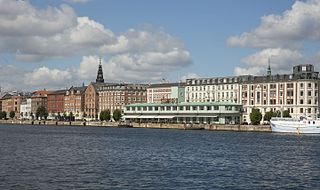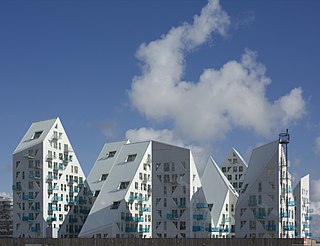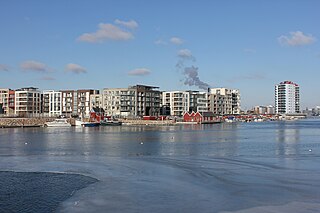
Christianshavn is a neighbourhood in Copenhagen, Denmark. Part of the Indre By District, it is located on several artificial islands between the islands of Zealand and Amager and separated from the rest of the city centre by the Inner Harbour. It was founded in the early 17th century by Christian IV as part of his extension of the fortifications of Copenhagen. Originally, it was laid out as an independent privileged merchant's town with inspiration from Dutch cities but it was soon incorporated into Copenhagen proper. Dominated by canals, it is the part of Copenhagen with the most nautical atmosphere.

The architecture of Denmark has its origins in the Viking period, richly revealed by archaeological finds. It became firmly established in the Middle Ages when first Romanesque, then Gothic churches and cathedrals sprang up throughout the country. It was during this period that, in a country with little access to stone, brick became the construction material of choice, not just for churches but also for fortifications and castles.

The architecture of Copenhagen in Denmark is characterised by a wide variety of styles, progressing through Christian IV's early 17th century landmarks and the elegant 17th century mansions and palaces of Frederiksstaden, to the late 19th century residential boroughs and cultural institutions to the modernistic contribution of the 20th century such as Arne Jacobsen's National Bank and SAS Royal Hotel

The Copenhagen Harbour Baths are a system of recreational bathing facilities along the waterfront of Copenhagen, Denmark. There are currently four harbour baths, the first and best-known of which is located at Islands Brygge.

Kay Otto Fisker, Hon. FAIA was a Danish architect, designer and educator. He is mostly known for his many housing projects, mainly in the Copenhagen area, and is considered a leading exponent of Danish Functionalism.
Henning Larsen Architects is an international architectural firm based in Copenhagen, Denmark. Founded in 1959 by noted Danish architect and namesake Henning Larsen, it has around 300 employees. In 2011, the company worked on projects in more than 20 countries.

Teglholmen is a peninsula in the South Harbour of Copenhagen, Denmark, located between Sluseholmen and Enghave Brygge. The former dockland area used to house heavy industry. While some industry activities remain in the area, but since most industry left the area, starting in the 1970s, it has undergone massive redevelopment, though some industrial activities remain, most notably MAN B&W Diesel's motor development plant. Today the area houses both a considerable number of Danish and regional headquarters of multinational companies and residential developments. Teglholmen is home to Aalborg University's AAU Cph Campus as well as TV 2's activities in Copenhagen.
Java-eiland is a neighbourhood of Amsterdam, Netherlands. It is located on a peninsula, surrounded on three sides by water and on the east by the KNSM Island neighbourhood.

Højbro Plads is a rectangular public square located between the adjoining Amagertorv and Slotsholmen Canal in the City Centre of Copenhagen, Denmark. It takes its name from the Højbro Bridge which connects it to the Slotsholmen island on the other side of the canal while Gammel Strand extends along the near side of the canal.

Arkitema Architects is a Danish architectural firm headquartered in Aarhus with branch offices in Copenhagen, Stockholm, Oslo and Malmö. Arkitema Architects has about 400 employees and is active mainly in the Scandinavian market.

Havnegade is a waterfront promenade in central Copenhagen, Denmark, which runs between Knippelsbro and the mouth of the Nyhavn canal. Most of the street is lined with buildings from the 1860s and 1870s that were constructed as part of the redevelopment of the Gammelholm navel dockyards. It is the only place along Copenhagen's main harbourfront where residential buildings of that age face the water, although older warehouses and other industrial buildings elsewhere have been converted into residential use. The Modernist Bank of Denmark building is located at the western end of the street.

Amerika Plads is a public square and surrounding neighbourhood in the Østerbro district of Copenhagen, Denmark. It is the result of a redevelopment of an area in the southern part of the former Freeport of Copenhagen into a mixed-use neighbourhood which consists of dwellings, offices and retail establishments, combining converted historic buildings and modern architecture. The former Free Port Station building was put in storage during the redevelopment and is now located in the middle of the square where it serves as a café. The area is to the west bounded by Kalkbrænderihavnsgade, part of a major thoroughfare, and to the east by Dampfærgevej connected to Kalkbrænderihavnsgade in both ends and separating Amerika Plads from America Quay, the western quay of the Southern Free Port dock. The name of the area, like that of the quay, is a reference to the large passenger ships which used to transport Danish emigrants to New York City during the first half of the 20th century.

The Royal Horse Guards Barracks, at 26 Frederiksholms Kanal in Copenhagen, Denmark, served as barracks for the Royal Horse Guards from 1792 until 1866. The building is located along the south side of a gated alleyway which connects Frederiksholm Canal to Vester Voldgade. Together with Civiletatens Materialgård and Fæstningens Materialgård, it forms a cluster of low, yellow-washed buildings all of which are listed, on the Zealand side of the canal, opposite the small island Slotsholmen with Christiansborg Palace. The Hay Storage Building at the end of the barracks building, facing Vester Voldgade, originally stored hay for the King's horses at the Royal Stables but later also served the Royal Horse Guards. Both the Royal Horse Guards Barracks and the Hay Storage building are now used by the Ministry of Education.

Porcelænshaven in the Frederiksberg district of Copenhagen, Denmark, is the former premises of the Royal Porcelain Manufactury, an industrial complex dating from the 1880s which was converted into a mixed-use neighbourhood in the 2000s. Located on the corner of Søndre Fasanvej and Smallegade, adjacent to Frederiksberg Gardens, it has an area of about five hectares and consists of a mixture of dwellings, commercial space and premises for Copenhagen Business School, whose main campus is located nearby. Many of the historical buildings have been retained, including a landmark chimney and the listed director's residence from 1908.

Havneholmen is a mixed-use development located on reclaimed land off Kalvebod Brygge in the harbor of Copenhagen, Denmark. It is located just east of the shopping centre Fisketorvet from which it is separated by a narrow canal, although it is annexed to mainland Kalvebod Brygge at its southern end.

Wildersgade is a street in the Christianshavn district of Copenhagen, Denmark. It runs along the length of the neighbourhood, parallel to Christianshavn Canal, one block to the east, from the Christiansbro development in the south(west) to Wilder's Canal in the north(east). The street is bisected by Torvegade, Christianshavn's principal thoroughfare, but is otherwise a quiet mainly residential street with cobbling and many old townhouses and storages from the 18th and 19th century.
Tredje Natur is a Copenhagen-based architectural firm specializing in urban design and planning. It was founded by Flemming Rafn Thomsen and Ole Schrøder in 2012. Malene Krüger joined the firm in January 2015.

Isbjerget is a residential building in the Aarhus Docklands neighborhood in Aarhus, Denmark. It is situated on the waterfront on Mariane Thomsens Gade and was finished in 2013 after three years of development. The building was designed by four architectural firms, the Danish CEBRA and JDS Architects, French Louis Paillard and Dutch SeARCH, and was funded by the Danish pension fund PensionDanmark.






















